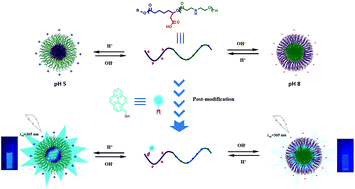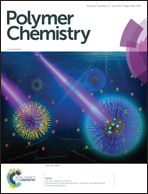Schizophrenic poly(ε-caprolactone)s: synthesis, self-assembly and fluorescent decoration†
Abstract
Double hydrophilic block copolymers (DHBCs) based on poly(ε-caprolactone)s, poly(6-acetoxyl-ε-caprolactone)-b-poly(4-N-piperilactone) (PCCL-b-PPIL), were synthesized via ring-opening polymerization and deprotection. The self-assembly behaviour of these block copolymers in aqueous solutions was thoroughly explored via a combination of UV-vis spectroscopy, zeta potential measurement, 1H NMR spectroscopy, dynamic light scattering (DLS) and transmission electron microscopy (TEM). It was observed that “schizophrenic” aggregations were formed and triggered by pH, i.e., the copolymers could self-assemble into PCCL-core micelles at acidic pH and PPIL-core micelles at alkaline pH. In addition, pendant groups in each block of copolymers facilitated further chemical modification with fluorescent dyes such as 1-(hydroxymethyl)pyrene and FITC. The fluorescence properties of pyrene-functionalized copolymers were closely related to their aggregate morphology, which could be adjusted simply by altering the environmental pH values. Meanwhile, it is expected that this novel type of degradable schizophrenic block copolymer holds potential application in stimuli-responsive fluorescent probes.



 Please wait while we load your content...
Please wait while we load your content...